| Published
on 9
Nov
2012 |
All rights reserved.
|
|
|
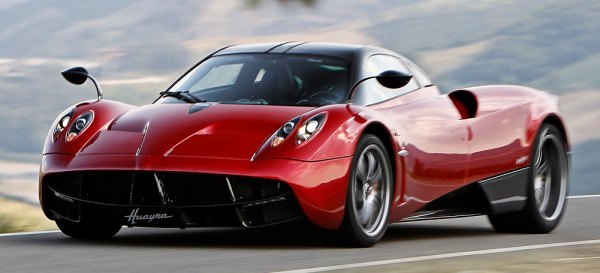
|
In the past decade the
supercar world has experienced a radical shift of power. Pagani has
emerged to the top tier (together with Koenigsegg and the reborn
Bugatti) as it offers the exclusivity, craftsmanship and engineering
excellence not even its Modena neighbors
could match. Through endless evolution, its C12 Zonda has become the
most sought after supercar in the world. However, originally designed
in the early 1990s, the Zonda has well past its planned lifespan,
whereas the supply of AMG M120 V12 is also coming to the end as AMG
committed to build only 250 units. Both reasons motivated Horacio
Pagani to develop his second generation supercar, C9 Huayra.
The Huayra is named after the God of Wind in South American legends.
More so than Zonda, it is shaped to enhance aerodynamics and cooling –
the former is required by its higher, 224 mph top speed, while the
latter is necessary for its now turbocharged V12 engine. The Huayra
might look a bit fatter and bulkier than the Zonda in pictures, but in
the real world you will find it more beautiful. Its curvier surfaces
appear more modern, its details more elegant and the build quality is
better than ever. As Horacio Pagani said, it combines Art and Science like the masterpieces
of Leonardo da Vinci. Some rivals,
say, Ferrari F12, might be more aerodynamic efficient, but their aero
aids usually spoil aesthetic. Unlike them, the Huayra captures your
imagination with its fighter jet-inspired shape. Its centrally mounted
quad-exhaust is definitely the highlight. Ditto the 4 movable aero
flaps that adjust downforce and maintain dynamic balance of the car.
Depending on their angles the coefficient of drag varies between 0.31
and 0.36. Viewing from the cockpit,
the regularly rising and falling flaps bring an extra sense of
occasion. In short, this car combines forms and functions
better than any other supercars.
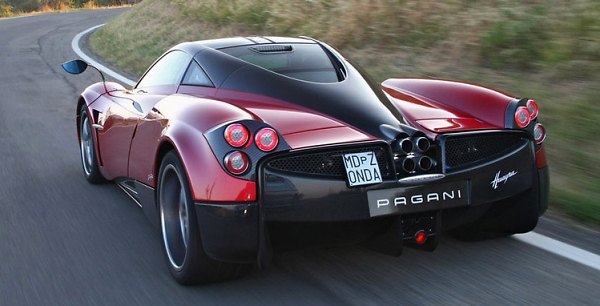 |
Like the last
Zonda
Cinque and Zonda R, the Huayra employs a stronger yet lighter kind of
carbon-fiber materials than those of its rivals – carbon-titanium. It
is made of titanium threads woven with carbon-fiber sheets. The central
tub, integrated roof frames and the whole bodywork are all made of this
exotic material. This helps the Huayra to achieve a dry weight of 1350
kg, some 225 kg and 490 kg less than Lamborghini Aventador and Bugatti
Veyron SS respectively. It is not as remarkable as the 1210 kg Zonda
Cinque though, mainly because of its heavier turbocharged engine,
enhanced comfort and compliance for the US market.
Bolted fore and aft of the load-bearing survival cell are subframes
made of chrome-moly steel. They provide mounting for the powertrain and
the all-double-wishbone suspensions. The latter is made of avional, an
aluminum-based alloy that is lighter than aluminum by 30 percent.
Predictably, racing-style in-board horizontal spring and damper units
are used. The front suspension has a hydropneumatic jack to avoid
damaging the nose on rough roads. Otherwise, the suspensions are purely
passive. The 19-inch front and 20-inch rear forged alloy wheels house
Brembo carbon-ceramic brakes and are shod with specially developed
Pirelli P-Zero tires.

|
Like us, Mr. Pagani preferred a naturally aspirated V12 for its sharper
throttle response and better sound quality, but obviously his request
was turned down by Mercedes on the ground of cost – although the
official reason is to reduce emission. What AMG offers is a 5980 c.c.
twin-turbo V12 with codename M158. It is derived from the one powering
the now retired SL65 AMG Black, and its roots can be traced back to the
S600 in 1998. No wonder it still employs cylinder heads with single
overhead camshaft
and 3 valves per
cylinder. There is neither variable valve timing nor direct injection.
What it does get are bespoke intake and exhaust system, new IHI
turbochargers, new intercoolers, dry-sump lubrication, revised ECU and
of course plenty of capacity and turbo boost. At merely 5800 rpm, it
releases 730 horsepower, 52 more than the last iteration of road-going
Zonda. Unsurprisingly, its torque delivery is even better. From 2250 to
4500 rpm it delivers the maximum 738 lbft or 1000 Nm of torque. This
could have been higher still if not limited by the gearbox, but who
cares?
One problem concerning the M158 twin-turbo V12 is its extra weight and
tremendous torque. The latter necessitates a stronger and heavier
gearbox which could hamper chassis balance further. That's why Pagani
adopted a 7-speed sequential gearbox built by British company Xtrac.
Compared with a modern twin-clutch transmission with comparable torque
capacity, it is at least 70 kg lighter. Moreover, the Xtrac unit has a
strong advantage in packaging because it is mounted transversely behind
the engine. As it does not protrude beyond the rear axle, weight
distribution is greatly improved. In addition to a lengthened wheelbase
(from the Zonda's 2730 to 2795 mm), the Huayra manages to attain 44:56
weight distribution, better than most mid-engined rear-drive supercars
and even the 4-wheel-drive Lamborghini Aventador.
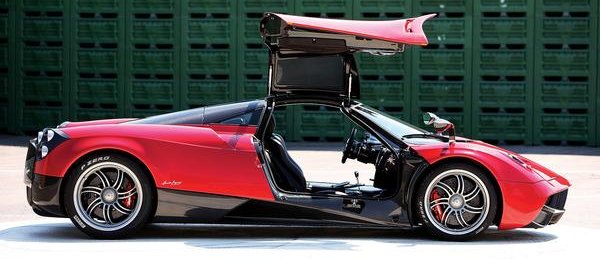
|
On the downside, the lack of twin-clutch gearbox means it is
impossible to launch the Pagani as quick as some rivals. Even with the
presence of electronic launch control, Pagani claims 3.2
seconds to sprint from standstill to 60 mph. That might be a magic
number in the days of McLaren F1, but today even a Nissan GT-R is good
for 2.9 seconds. Is the Pagani too tamed?
No, of course not. The Huayra's power-to-weight ratio guarantees
spectacular performance once it has overcome initial tire slip.
Moreover, the attraction of Pagani has always been more than numbers...
Swing up the gullwing door, you will find the most beautiful cockpit
in the sports car industry. Its extensive use of carbon-fiber and
CNC-milled aluminum parts is astonishing, and their finishing is first
rate. Equally amazing are the jewel-like instruments, bespoke switches,
stylish air vents
and exposed gearshift mechanism – if da Vinci designed a car today, it
could have looked like this one! Style aside, the cockpit also
functions very well. There is excellent visibility to the front as the
windscreen is deep and expansive. Less so to the back but still better
than most supercars. The glass roof leads to a light and airy ambience
not found
in its rivals. The space and seating comfort are excellent. Entry to
the cabin is easy, thanks to the gullwing doors. A modern satellite
navigation screen and a
stylish driving information display guarantee convenience of use.
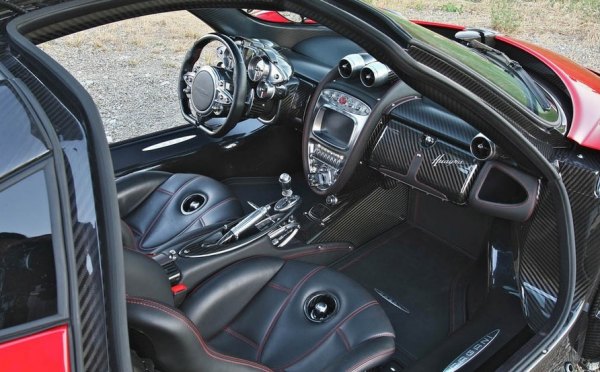
|
The Huayra does not start with push-button but the
most elegant ignition key we have ever seen – it is a miniature Huayra
milled from solid aluminum. Fire the engine, however, you might be
slightly disappointed. The AMG twin-turbo V12 does not sing as
beautifully as the outgoing 7.3-liter unit at any rev. Its bass
soundtrack is occupied with busy whoosh and whistles from the turbo
wastegates which sound more noises than music in the ears of
purists. Unsurprisingly, throttle response is not as sharp, too, but
this engine has precious little turbo lag – less than the one on SL65
Black because of the smaller turbines it used. It would pull smoothly
from as
little as 1000 rpm, but its true colors lie beyond 2500 rpm, when a
rush of thrust surges the car forward, pressing your head hard on the
headrest.
Keep pressuring the throttle and you will exceed triple-digit speed in
the blink of eye. Forget that 0-60 claim, this is really one of the
fastest cars on the planet, one that needs your full commitment to the
driving when its wild temper is released.
With 738 pound-foot of torque running through the rear wheels, the
Huayra is not as easy to drive as Bugatti Veyron or Ferrari F12, of
course. However, it is neither as difficult to tame as imagined. Thanks
to incredible traction and grip generated by those Pirelli rubbers, it
is not easy to spin or slide unless you deliberately do so, at
least on dry surface. While the Xtrac gearbox is nowhere as smooth as
DCTs, its gearshift is fast, and the shift quality is not as brutal
as that of Lamborghini Aventador.
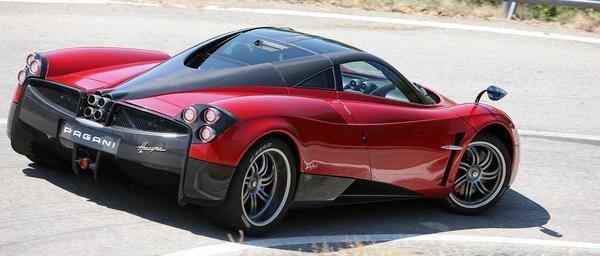
|
Like Zonda, the Huayra rides with suppleness rarely seen on
supercars. It feels at home on mountain roads, in town as well as on
highway. This versatile manner makes it a lot more usable than
the single-minded Koenigsegg. You can drive it for a cross-country trip
if you don't
mind its lack of luggage space. Meanwhile, the car also corners
beautifully. It shows excellent balance and body control. The active
aero flaps keep it stable through corners. The hydraulic steering is
quick and old-school
communicative. The ceramic brakes are immensely powerful, accompanied
with
excellent pedal feel, too. At the limit, its handling is fairly
progressive. As long as you control the throttle sensibly and act fast
on the steering, you can induce oversteer in slow corners. On regular
roads,
the Huayra is more agile and adjustable than Bugatti and Koenigsegg.
Nevertheless, compare with the previous Zonda, some sense of agility
and feel has been lost.
In order to tame its beast side, Pagani has dialed some initial
understeer into its
suspension geometry and increased its steering effort. This makes it
feel less sensitive and less transparent to the driver. Purists will
also prefer
Zonda for its keener throttle response, linear power delivery and
better sound
quality, whereas Huayra will attract those pursuing dramatic
performance, sense of occasion and the best build quality. In other
words, it is a better car to compete with Bugatti and Koenigsegg. Is it
a
better car than those? If you appreciate the art-and-science philosophy
of Leonardo da
Vinci, the answer will be definitely yes.
No wonder Pagani has already got 96 units or more than 2 years worth of
orders, even though each costing
845,000 euros plus tax! If you place order now, you won't get delivery
until 2015. No kidding!
|
Verdict:      |
Published
on 5
Nov 2021
|
All rights reserved.
|
|
Huayra BC Roadster
|
|
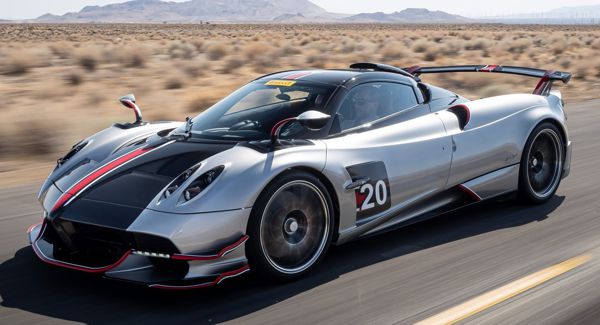
|
|
There
must be some good reasons why a €3.2 million car could sell out before
announcement...
|
|
In
the world of hypercars, Pagani is rather old-school. Built by hands and
crafted like a piece of art, using the most expensive and the lightest
materials available, but the powertrain is old-school V12 and it drives
the rear wheels through a single-clutch gearbox in conventional way. No
all-wheel drive to spread its tremendous torque. No clever electronics
like Ferrari to put down its power controllably. No clever suspension
tech like McLaren. No hybrid power assistance, torque-fill or
torque-vectoring, of
course. Horacio Pagani doesn’t care what direction other hypercar
makers are chasing. Top speed, 0-60, 0-186-0, Nurburgring lap time, all
are not important to him. Because Pagani is a small company, because
each car is sold at millions of dollars, Pagani is content to build
only a few dozen cars a year. He has never worried about lack of
orders. Whatever new cars
he introduced, his loyal customers snapped up all quotas immediately –
in fact, usually before announcement.
The current Huayra entered production in 2012. That’s a long time ago
for a hypercar, but Pagani keeps introducing special editions, and one
better than one. The Huayra BC was introduced in 2016 and entered
production the following year. It was named after the late Benny
Caiola, the
first ever customer of Pagani, also a friend of Horacio and his
motivator. With extended front splitter, side vanes, a high-mounted
rear wing and Le Mans-car-like massive diffusers, this car is obviously
more track-friendly, but it loses virtually nothing in road driving. It
looks better, too, as those extra wings and spoilers add aggression
that the original Huayra lacks. Power output of the 6-liter AMG
twin-turbo V12 was lifted from 730 to 764 hp, while dry weight dropped
from 1350 to 1218 kg thanks to using lighter body panels made of a new
kind of carbon-fiber, a titanium exhaust, lighter brake calipers,
lighter forged alloy wheels and a lighter gearbox, though the latter
remains a
7-speed automated manual supplied by Xtrac. This car was priced at €1.6
million plus tax, or double of the original Huayra. It took Pagani 2
years to
finish the promised batch of 20 cars.
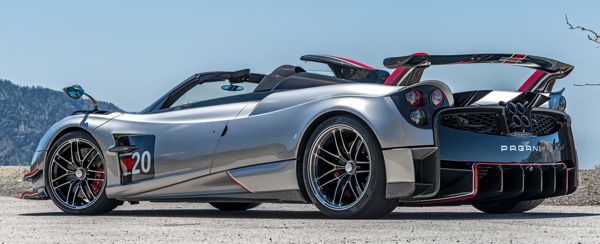
|
|
Apart
from the usual center-exit quad-exhaust, the Roadster added 2 underbody
exhaust to realize "blown diffuser" and a lot more noise.
|
|
After the
completion of BC, Pagani introduced the Roadster version. This time,
the quota is doubled to 40 cars, but the price is also doubled to €3.2
million before tax.
Normally, I am not interested in roadster version of any coupes. Not
this one, because it looks even better. Pagani used the 2 years gap to
improve the Roadster in many areas, starting from aerodynamics. The
front splitter, side skirt and rear wing were reshaped to look sleeker
and more stylish while still generate 500 kg of downforce at 280 km/h
(174 mph). An optional roof snorkel adds further sense of occasion.
Losing the roof does not hurt chassis rigidity, and it adds only 32 kg
to the dry weight, which is a class-leading 1250 kg. Thanks must go to
the use of both carbon-titanium and carbon-triax materials for its
chassis and body.
Meanwhile, AMG redeveloped the V12 motor, using larger turbos and
intercoolers to boost its output to 802 horsepower and 774 pound-foot
of torque. This means, the power-to-weight ratio of BC Roadster is
higher than its coupe sibling. Interestingly, the Roadster adopts
F1-style blown-diffuser. The Huayra’s signature center-exit
quad-exhaust remains intact, but 2 more invisible exhausts are added at
the underbody, exiting straight from the catalytic converters and
injecting hot stream of exhaust to the diffusers. Apart from adding
downforce, they produce extra noise.
At the chassis, the biggest change is replacing the coupe’s Ohlins
manually adjustable dampers with electronic-controlled dampers. As a
result, stiffness and ride height change according to driving modes
(Comfort, Sport or Race). Not exactly adaptive, but it gives the
Roadster a broader range of ability. The Roadster also gets larger
Brembo CCM brakes up front, with 398mm discs clamped by 6-pot calipers,
while the rear remains at 380mm and 4-pot. The coupe’s bespoke Pirelli
P-Zero Trofeo R rubbers are carried over.
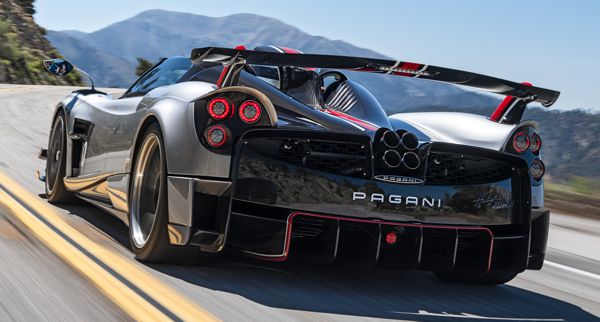
|
|
Track-oriented
rubbers and downforce allow Pagani to claim as much as 1.9 g in corner.
|
|
On the
road, the first impression is: what a noise! The AMG V12 is
astonishingly loud when you press it on motorway. The combination of 4
titanium tailpipes, 2 straight out underbody exhausts, the lack of
sound insulation and the hollow effect of the bare carbon-fiber
monocoque all contribute to the mad soundtrack. You don’t even need to
detach the roof to enjoy the tremendous noise. It pops and crackles
angrily whenever you back off. Its turbo wastegates whoosh and whistle
on overrun. Who said turbocharged engines are boring?
Turbo lag is noticeable, but the V12’s delivery is quite linear in
normal driving. However, it gets trickier to launch from a standstill,
because it has enough torque to spin the rear tires – despite the
massive size of 355-section – in the first 2 gears. Remember, only a
handful of cars can compare with its 774 lbft of maximum torque, and
none is quite as lightweight. Moreover, the Pagani’s traction control
is far from sophisticated. This is why Car & Driver timed an
unremarkable 3.3 seconds to go from 0-60 mph. However, once getting
into triple digit speed, it storms forward like an arrow. Maybe not as
strong as Bugatti or Koegnisegg or just any of the latest hybrid
exotic, but I doubt if you can feel the difference on the road,
especially when you are immersed in the thunderous engine noise.
Unfortunately, the Xtrac automated manual gearbox is the weak point. It
is claimed to halve the shift time to 75ms, but you can feel the pause
and shock during each gearchange. Why didn’t Pagani opt for a DCT? The
official answer is weight penalty, but I suppose there is currently no
DCT on the market could handle more than 664 lbft of torque. For a
mid-engined application, even no more than 590 lbft. Maybe Tremec could
make one for the next Corvette ZR1, just like what Ricardo did
exclusively for Bugatti, but the low volume of Pagani is difficult to
persuade any gearbox specialists to build one.
That’s a pity, because the BC Roadster rides and handles very well. Its
ride is surprisingly livable in Comfort mode for a car looking like a
track special. Its roadholding is tremendous, thanks to those
track-oriented rubbers and downforce that allow Pagani to claim as much
as 1.9 g in corner. Braking is powerful and pedal feel is excellent.
The steering is suitably geared to avoid nervous reaction.
Understandably, there is some understeer built into the chassis to
avoid abusing its power, but you can dial into a bit of oversteer with
steering and throttle. Want to enjoy the endless fun of powerslide as
in a Ferrari 488 Pista? Sorry, the traction control won’t allow big
slide. Switch it off and you will need to be absolutely concentrated
and subtle with your inputs to keep it on track. However, neither
Koenigsegg nor Bugatti will do that like a Pista as well. The Pagani
might be slower and less sophisticated than both rivals, but it feels
more analogue, more charismatic and more artful. Only the flawed
gearbox, traction management and turbo lag stand in the way of being as
great as Zonda used to be.
|
Verdict:     |
|